Chapter: Mechanical : Strength of Materials : Stress, Strain and Deformation of Solids
Types of Stresses
TYPES OF STRESSES :
Only two basic stresses exists : (1) normal stress
and (2) shear shear stress. Other stresses either are similar to these basic
stresses or are a combination of these e.g. bending stress is a combination
tensile, compressive and shear stresses. Torsional stress, as encountered in
twisting of a shaft is a shearing stress.
Let
us define the normal stresses and shear stresses in the following sections.
Normal stresses : We
have defined stress as force per unit area. If the stresses are normal to
the areas concerned, then these are termed as normal stresses. The normal
stresses are generally denoted by a Greek letter ( s )
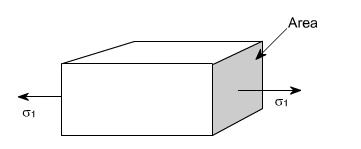
This is also known as uniaxial state of stress,
because the stresses acts only in one direction however, such a state rarely
exists, therefore we have biaxial and triaxial state of stresses where either
the two mutually perpendicular normal stresses acts or three mutually
perpendicular normal stresses acts as shown in the figures below :
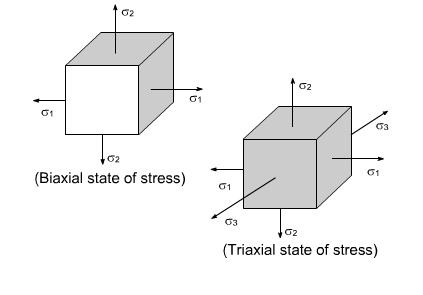
Tensile
or compressive stresses :
The normal stresses can be either tensile or
compressive whether the stresses acts out of the area or into the area
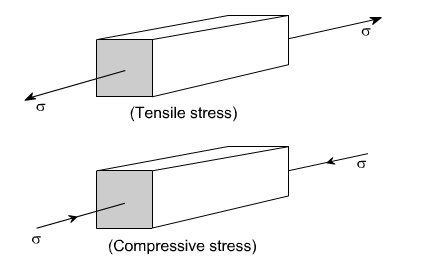
Bearing Stress : When
one object presses against another, it is referred to a bearing stress (
They are in fact the compressive stresses ).
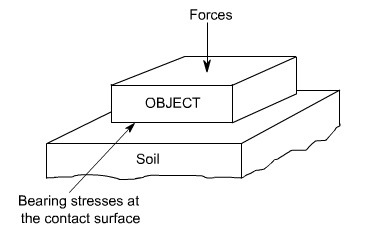
Shear
stresses :
Let us consider now the situation, where the cross
–sectional area of a block of material is subject to a distribution of forces
which are parallel, rather than normal, to the area concerned. Such forces are
associated with a shearing of the material, and are referred to as shear
forces. The resulting force interistes are known as shear stresses.
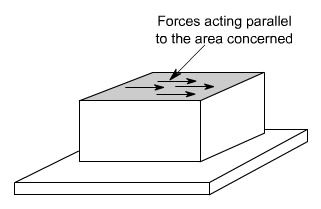
The resulting force intensities are known as shear
stresses, the mean shear stress being equal to

Where
P is the total force and A the area over which it acts.
Stress
is defined as the force per unit area. Thus, the formula for calculating stress
is:
s=
F/A
Where s denotes stress, F is load and A is the cross
sectional area. The most commonly used units for stress are the SI units, or
Pascals (or N/m2), although other units like psi (pounds per square
inch) are sometimes used.
Forces
may be applied in different directions such as:
•
Tensile or stretching
•
Compressive or squashing/crushing
•
Shear or tearing/cutting
•
Torsional or twisting
This gives rise to numerous corresponding types of
stresses and hence measure/quoted strengths. While data sheets often quote
values for strength (e.g compressive strength), these values are purely
uniaxial, and it should be noted that in real life several different stresses
may be acting.
Tensile
Strength
The tensile strength is defined as the maximum
tensile load a body can withstand before failure divided by its cross sectional
area. This property is also sometimes referred to Ultimate Tensile Stress or
UTS.
Typically, ceramics perform poorly in tension, while
metals are quite good. Fibres such as glass, Kevlar and carbon fibre are often
added polymeric materials in the direction of the tensile force to reinforce or
improve their tensile strength.
Compressive
Strength
Compressive strength is defined as the maximum
compressive load a body can bear prior to failure, divided by its cross
sectional area.
Ceramics typically have good tensile strengths and
are used under compression e.g. concrete.
Shear
Strength
Shear strength is the maximum shear load a body can
withstand before failure occurs divided by its cross sectional area.
This property is relevant to adhesives and fasteners
as well as in operations like the guillotining of sheet metals.
Torsional
Strength
Torsional
strength is the maximum amount of torsional stress a body can withstand before
it fails, divided by its cross sectional area.
This
property is relevant for components such as shafts.
Yield
Strength
Yield
strength is defined as the stress at which a material changes from elastic
deformation to plastic deformation. Once the this point, known as the yield
point is exceeded, the materials will no longer return to its original
dimensions after the removal of the stress.
Stress
is defined as the force per unit area. Thus, the formula for calculating stress
is:
Where s denotes stress, F is load and A is the cross
sectional area. The most commonly used units for stress are the SI units, or
Pascals (or N/m2), although other units like psi (pounds per square
inch) are sometimes used.
Forces
may be applied in different directions such as:
•
Tensile or stretching
•
Compressive or squashing/crushing
•
Shear or tearing/cutting
•
Torsion or twisting
This gives rise to numerous corresponding types of
stresses and hence measure/quoted strengths. While data sheets often quote
values for strength (e.g compressive strength), these values are purely uni
axial, and it should be noted that in real life several different stresses may
be acting
Deformation
of simple bars under axial load Deformation of bodies
Concept of strain : if
a bar is subjected to a direct load, and hence a stress the bar will change
in length. If the bar has an original length L and changes by an amount dL, the
strain produce is defined as follows:
Strain is thus, a measure of the deformation of the
material and is a non dimensional Quantity i.e. it has no units. It is simply a
ratio of two quantities with the same unit.
Shear strain: As
we know that the shear stresses acts along the surface. The action of the stresses
is to produce or being about the deformation in the body consider the
distortion produced b shear sheer stress on an element or rectangular block
This shear strain or slide is f and can be defined as the change in right
angle. or The angle of deformation g is then termed as the shear strain. Shear
strain is measured in radians & hence is non –dimensional
i.e.
it has no unit .So we have two types of strain i.e. normal stress & shear
stresses.
Hook's
Law :
A material is said to be elastic if it returns to
its original, unloaded dimensions when load is removed.
Hook's
law therefore states that Stress ( s ) a strain( Î )
Modulus of elasticity : Within
the elastic limits of materials i.e. within the limits in which Hook's
law applies, it has been shown that
Stress
/ strain = constant
This constant is given by the symbol E and is termed
as the modulus of elasticity or Young's modulus of elasticity Thus ,The value
of Young's modulus E is generally assumed to be the same in tension or
compression and for most engineering material has high, numerical value of the
order of 200 GPa
Poisson's ratio: If
a bar is subjected to a longitudinal stress there will be a strain in this direction
equal to s / E . There will also be a strain in all directions at right angles
to s . The final shape being shown by the dotted lines.
It has been observed that for an elastic materials,
the lateral strain is proportional to the longitudinal strain. The ratio of the
lateral strain to longitudinal strain is known as the poison's ratio .
Poison's
ratio ( m ) = - lateral strain / longitudinal strain
For
most engineering materials the value of m his between 0.25 and 0.33.
Deformation
of compound bars under axial load
For a prismatic bar loaded in tension by an axial
force P, the elongation of the bar can be determined as Suppose the bar is
loaded at one or more intermediate positions, then equation
(1) can be readily adapted to handle this situation,
i.e. we can determine the axial force in each part of the bar i.e. parts AB,
BC, CD, and calculate the elongation or shortening of each part separately,
finally, these changes in lengths can be added algebraically to obtain the
total charge in length of the entire bar.
When either the axial force or the cross –sectional
area varies continuosly along the axis of the bar, then equation (1) is no
longer suitable. Instead, the elongation can be found by considering a
deferential element of a bar and then the equation (1) becomes i.e. the axial
force Pxand area of the cross –section Ax must be expressed as functions of x.
If the expressions for Pxand Ax are not too complicated, the integral can be
evaluated analytically,
otherwise
Numerical methods or techniques can be used to evaluate these integrals.
Related Topics